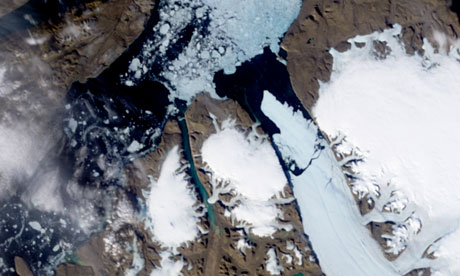Greenland ice sheet faces 'tipping point in 10 years'

The entire ice mass of Greenland will disappear from the world map if temperatures rise by as little as 2C, with severe consequences for the rest of the world, a panel of scientists told Congress today.
Greenland shed its largest chunk of ice in nearly half a century last week, and faces an even grimmer future, according to Richard Alley, a geosciences professor at Pennsylvania State University
“Sometime in the next decade we may pass that tipping point which would put us warmer than temperatures that Greenland can survive,” Alley told a briefing in Congress, adding that a rise in the range of 2C to 7C would mean the obliteration of Greenland’s ice sheet.
The fall-out would be felt thousands of miles away from the Arctic, unleashing a global sea level rise of 23ft (7 metres), Alley warned. Low-lying cities such as New Orleans would vanish.
“What is going on in the Arctic now is the biggest and fastest thing that nature has ever done,” he said.
Speaking by phone, Alley was addressing a briefing held by the House of Representatives committee on energy independence and global warming.
Greenland is losing ice mass at an increasing rate, dumping more icebergs into the ocean because of warming temperatures, he said.
The stark warning was underlined by the momentous break-up of one of Greenland’s largest glaciers last week, which set a 100 sq mile chunk of ice drifting into the North Strait between Greenland and Canada.
The briefing also noted that the last six months had set new temperature records.
Robert Bindschadler, a research scientist at the University of Maryland, told the briefing: “While we don’t believe it is possible to lose an ice sheet within a decade, we do believe it is possible to reach a tipping point in a few decades in which we would lose the ice sheet in a century.”
The ice loss from the Petermann Glacier was the largest such event in nearly 50 years, although there have been regular and smaller “calvings”.
Petermann spawned two smaller breakaways: one of 34 sq miles in 2001 and another of 10 sq miles in 2008.
Andreas Muenchow, professor of ocean science at the University of Delaware, who has been studying the Petermann glacier for several years, said he had been expecting such a break, although he did not anticipate its size.
He also argued that much remains unknown about the interaction between Arctic sea ice, sea level, and temperature rise.
Muenchow told the briefing that over the last seven years he had only received funding to measure ocean temperatures near the Petermann Glacier for a total of three days.
He was also reduced, because of a lack of funding, to paying his own airfare and that of his students to they could join up with a Canadian icebreaker on a joint research project in the Arctic.
Guardian News website
